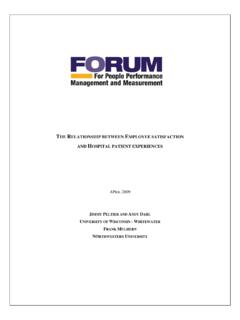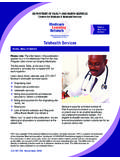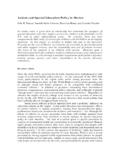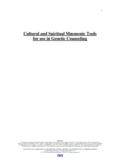Transcription of Three Key Trends for The Future of HR Management
1 HR: Leading People, Leading OrganizationsThree Key Trends for The Future of HR ManagementPresented bySociety for Human Resource ManagementHR: Leading People, Leading OrganizationsToday s Agenda Importance of planning ahead SHRM 2006-2007 Workplace Forecast Scenario planning Competencies necessary to respond to emerging Trends How SHRM can helpSlide 1HR: Leading People, Leading OrganizationsWhy plan ahead?According to Jim O Toole and Ed Lawler: ..national productivity is determined by the efforts, initiativeand skills of employees. If workers are not committed, motivated, engaged, trained, and appropriately supervised, they will with disastrous consequences for a nation s global competitiveness.
2 Source: O Toole, J., and Lawler, E., The New American Workplace, 2HR: Leading People, Leading Organizations It s not enough to be busy. The question is, what are we busy about? -Henry David ThoreauSlide 3HR: Leading People, Leading OrganizationsHR: Not without 2005issue of Fast CompanymagazineSlide 4HR: Leading People, Leading OrganizationsOn the flip JOBSIN AMERICAS ource: MONEY Magazine and 5HR: Leading People, Leading OrganizationsOn the flip JOBSIN AMERICAWhy it s great: ..HR is no longer about benefits administration and the employee newsletter. Those tasks are increasingly outsourced, and directors and vp sare considered strategic planners.
3 Even lower-level managers are expected to design employee programs that benefit the bottom HR and compliance are especially hot. There's a wide variety of work, from self-employed benefits specialists to corporate recruiters and HR generalists. Source: MONEY Magazine and 6HR: Leading People, Leading OrganizationsOn the flip JOBSIN AMERICAWhat's Cool:The mission to make work more rewarding for workers. You help shape corporate culture and strategy. What's Not Cool: Fighting the "fluffy HR" stereotype; firing job:Senior HR directors make around $285,000; at the C-suite level $1 :Bachelor's degree, often followed by master's level work or professional : MONEY Magazine and 7HR: Leading People, Leading OrganizationsAdding Value5 competenciesthrough which HR adds value: Strategic contribution Business acumen Personal credibility HR delivery HR technology(Source: Competencies for the New HR, Univ.)
4 Of Michigan, RBL Group and SHRM.)Anticipating and managing change is crucial to all five competencies!Slide 8HR: Leading People, Leading OrganizationsAdding ValueStrategic Contribution: Accounts for 43% of HR s total impact on business performance Means anticipating change and putting systems in place to rapidly align employee behaviors with evolving organizational needs.(Source: Competencies for the New HR, Univ. of Michigan, RBL Group and SHRM.)Slide 9HR: Leading People, Leading Organizations2006 SHRM Workplace 10HR: Leading People, Leading Organizations2006 SHRM Workplace ForecastTrend areas:Demographics, Economics, Employment, HR Profession, International, Politics, Science & Technology, and overarching themes: Demographic changes Rising cost of health care Increased global competitiveness Slide 11HR: Leading People, Leading OrganizationsTheme #1: Demographics More childless couples, same sex couples, andsingle-parent households.
5 Unmarried adults headclose to half of American households. Stay-at-home moms, workers with disabilities orsemi-retired workers teleworking. Hispanic population nearly doubled since 1990. Growth in number of employees for whom Englishis a second language. More religious : Census Bureau and Bureau of Labor StatisticsSlide 12HR: Leading People, Leading OrganizationsTheme #1: DemographicsAging of the workforce44% of HR professionals say major impact Workers aged 55+ may increase by half between2002 and 2012. Insufficient saving means working into retirement Baby Boomer retirement, loss of executives Impact on pension plans, retiree health costs Employees stretched with care of children/parentsSlide 13HR: Leading People, Leading OrganizationsTheme #1: DemographicsPreparation for potential labor shortage due to baby boomer retirement 30% of employees may retire over next 10 years Only 11% of companies have implemented specific changes 38% just becoming aware of the issue 51% in the process of addressing the issueSlide 14HR: Leading People, Leading OrganizationsTheme #1: DemographicsRetention.
6 80%of workers say they are very likely or somewhat likely to step up job search as the job market improves. Source: SHRM 2005 Job Recovery and Retention Poll Slide 15HR: Leading People, Leading OrganizationsTheme #1: DemographicsSandwich Generation13% of Americans aged 41-59 are sandwiched between caring for their young children and aging parents at the same time.(Source: Pew Research Center 2005 Survey)Slide 16HR: Leading People, Leading OrganizationsTheme #1: Demographics14%21%12%18%35%Personal IllnessFamily NeedsStressEntitlementPersonal NeedsReasons for Unscheduled Absenteeism35%-Personal Illness65% -OtherSource: CCH 2006 Unscheduled Absence SurveySlide 17HR: Leading People, Leading OrganizationsTheme #2: Health Care CostsHealth care cost cutting vs.
7 Employee retentionSlide 18HR: Leading People, Leading OrganizationsTheme #2: Health Care Costs2006 health care expenses for companies are estimated to cost an average of more than$8,400 per employee(Source: 2006 Health Care Cost Survey, Towers Perrin)Slide 19HR: Leading People, Leading OrganizationsTheme #2: Health Care CostsCosts untenable for many employers because: Companies spending more unproductive time designing and redesigning healthcare programs to reduce costs Healthcare benefits have become the major sticking issue in union/ Management relations Rising costs creating ethical dilemmas for executives Executives making major decisions about jobs and outsourcing based on analyses of healthcare costs American exports are at a competitive disadvantage Older companies with many retirees face : O Toole, J.
8 And Lawler, E., The New American WorkplaceSlide 20HR: Leading People, Leading OrganizationsTheme #2: Health Care CostsSome employer options: Limiting or eliminating coverage Higher co-pays Spousal surcharge Wellness and disease Management programsSlide 23HR: Leading People, Leading OrganizationsTheme #2: Health Care CostsPerdue Farm s Health Improvement Program initiative focuses on improving employee health in five areas: blood pressure cholesterol tobacco use weight control exercise75% reduction in number of employees with high blood pressure!Slide 22HR: Leading People, Leading OrganizationsWellness programs: Number 1 cost-control strategy of large employers Increase in # of companies with wellness programs: 57% in 2004 to 67% in 2005 (source: Mercer 2005 survey)Consumer-driven health plans (CDHPs): First-time CDHP participants had 8% decrease in medical costs(source: 2006 CIGNA Health Care Analysis) 35% of CDHP participants delayed or avoided needed health care vs.
9 17% with comprehensive plans (source: Employee Benefit Research Institute) Theme #2: Health Care CostsSlide 23HR: Leading People, Leading OrganizationsTheme #2: Health Care CostsState legislative initiatives: 400 bills on prescription drugs considered in 2006. MD Employers with 10,000+ employees must spend at least 8% of payroll on health benefits or put money into state health program. 30 states considering similar bills. VT Mandatory employer contributions for each full-time employee without health care coverage. Effective 4/07. MA Employers with 11+ full-time employees not offering coverage pays $295 annually 10 24HR: Leading People, Leading OrganizationsTheme #2: Health Care CostsHR professionals should: pay close attention to the Trends research the options be specific about goals closely monitor and measure programs communicate with employees about wellness, careful use of health care resources, and the full investment the organization is makingSlide 25HR: Leading People, Leading OrganizationsTheme #3: Globalization 37%of HR professionals say global expansion is likely to have a major impact on the workplace.
10 36%say their organizations are planning to expand into the global : SHRM 2005 Offshoring Survey ReportSlide 26HR: Leading People, Leading OrganizationsTheme #3: GlobalizationTop 5 most attractive offshoring destination countries in 2005: India China Malaysia Philippines SingaporeSource: Kearney 2005 Global Services Location IndexSlide 27HR: Leading People, Leading OrganizationsTheme #3: GlobalizationNearly 3 in 10 companies offshore one or more business to OffshoreLower labor costs54%New business opportunities41%Access to technical skills26%Lower health care costs5%Regulatory environment2%Source: SHRM 2005 Offshoring Survey ReportSlide 28HR: Leading People, Leading OrganizationsTheme #3: GlobalizationOffshoring Issues for HR to consider: Impact on employee morale Country-specific cultural issues Impact of different corporate culture Possible investor/customer backlash Security risks Natural disastersin certain regions Does offshoringfit into an organization s strategic direction?







